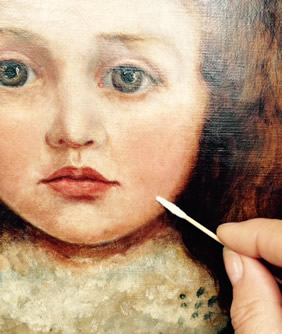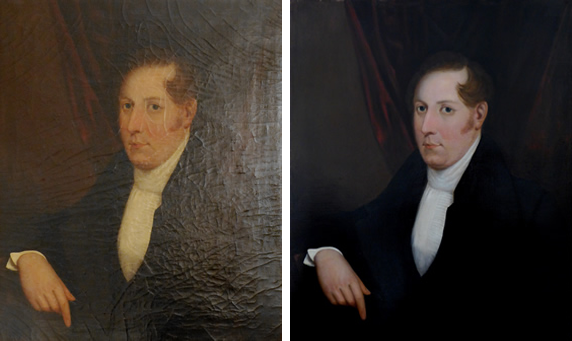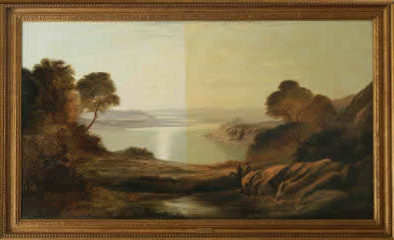Cleaning & Consolidation
Cleaning & Consolidation

Dust and dirt on the painting surface has a tendency to give a grey, dull appearance, while nicotine deposits leave a yellow layer.
The varnish layers applied originally and sometimes re-applied over time discolour to leave the painting with an orange brown appearance. Old restoration retouching and inpainting also often darken and change.
These issues combine to significantly change the way a painting looks from the artist’s intentions. Tests are carried out in the studio to identify a suitable cleaning solvent and the dirt layers are then carefully removed.
Dust and dirt on the painting surface has a tendency to give a grey, dull appearance, while nicotine deposits leave a yellow layer.
The varnish layers applied originally and sometimes re-applied over time discolour to leave the painting with an orange brown appearance. Old restoration retouching and inpainting also often darken and change.
These issues combine to significantly change the way a painting looks from the artist’s intentions. Tests are carried out in the studio to identify a suitable cleaning solvent and the dirt layers are then carefully removed.
Dust and dirt on the painting surface has a tendency to give a grey, dull appearance, while nicotine deposits leave a yellow layer.
The varnish layers applied originally and sometimes re-applied over time discolour to leave the painting with an orange brown appearance. Old restoration retouching and inpainting also often darken and change.
These issues combine to significantly change the way a painting looks from the artist’s intentions. Tests are carried out in the studio to identify a suitable cleaning solvent and the dirt layers are then carefully removed.
Canvas responds to changes in the environment which can cause stresses and lifting of the paint layer.
Cracks can appear, particularly when the painting has been exposed to damp conditions.
Canvas responds to changes in the environment which can cause stresses and lifting of the paint layer.
Cracks can appear, particularly when the painting has been exposed to damp conditions.
Canvas responds to changes in the environment which can cause stresses and lifting of the paint layer.
Cracks can appear, particularly when the painting has been exposed to damp conditions.
Flaking paint should be treated as quickly as possible to prevent further deterioration and paint loss. In less severe cases flakes and lifting areas can be consolidated locally but more extreme areas of paint loss and cracking need to be lined onto a new canvas.
Details of a portrait of Joseph Gell showing the badly flaking areas where the paint layer was lifting away from the canvas. The second photograph shows the painting after lining and cleaning.
Flaking paint should be treated as quickly as possible to prevent further deterioration and paint loss. In less severe cases flakes and lifting areas can be consolidated locally but more extreme areas of paint loss and cracking need to be lined onto a new canvas.
Details of a portrait of Joseph Gell showing the badly flaking areas where the paint layer was lifting away from the canvas. The second photograph shows the painting after lining and cleaning.
Flaking paint should be treated as quickly as possible to prevent further deterioration and paint loss. In less severe cases flakes and lifting areas can be consolidated locally but more extreme areas of paint loss and cracking need to be lined onto a new canvas.
Details of a portrait of Joseph Gell showing the badly flaking areas where the paint layer was lifting away from the canvas. The second photograph shows the painting after lining and cleaning.

Where the outer margins of a canvas have deteriorated and come away from the support the painting can be strip lined by applying fabric strips to the edges in order to strengthen them.
Smaller tears, holes, punctures and threads can be mended and secured without completely lining the canvas. This is recommended as it offers minimum interference with the integrity of the painting.
After consolidation losses to the paint layer are filled to match the structure of the surrounding texture. Paint is then applied to the filled areas to correspond to the original picture. Colours are matched and if necessary missing areas of the composition are reconstructed.
Where the outer margins of a canvas have deteriorated and come away from the support the painting can be strip lined by applying fabric strips to the edges in order to strengthen them.
Smaller tears, holes, punctures and threads can be mended and secured without completely lining the canvas. This is recommended as it offers minimum interference with the integrity of the painting.
After consolidation losses to the paint layer are filled to match the structure of the surrounding texture. Paint is then applied to the filled areas to correspond to the original picture. Colours are matched and if necessary missing areas of the composition are reconstructed.

A 19th century landscape signed Charles Leslie
Shown halfway in the cleaning process.
A 19th century landscape signed Charles Leslie
Shown halfway in the cleaning process.

Contact Us:
Phone: 01206 769664
Email: mlynchptg@outlook.com
Address: Cowdray Avenue, Colchester
Contact Us:
Phone: 01206 769664
Email: mlynchptg@outlook.com
Address: Cowdray Avenue, Colchester
Contact Us:
Phone: 01206 769664
Email: mlynchptg@outlook.com
Address: Cowdray Avenue, Colchester